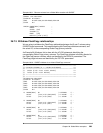
Chapter 26. Global Mirror examples 373
26.9 Set up a Global Mirror environment using DS SM
You may establish a Global Mirror environment with the DS Storage Manager (DS SM) that
provides a graphical user interface (GUI).
A Global Mirror session relies on the following components, which are independent of the
interface used, but are repeated here in case you are only reading this section:
Paths for Global Copy communication between primary and secondary LSSs. Paths may
also be required for communication between Master and Subordinate LSSs, in case these
LSSs reside on different primary storage disk subsystems.
Global Copy pairs: primary A volumes and secondary B volumes.
FlashCopy pairs, which are part of Global Mirror. These FlashCopy relationships are
established at the secondary (remote) site between the B and C volumes. Note that the B
volumes are not only the FlashCopy source, but they are also Global Copy secondaries at
the same time. The C volumes are the FlashCopy target volumes.
Up to eight storage images can contribute their volumes to a Global Mirror session at the
primary site. The same number applies for the secondary site.
The creation of a Global Mirror session requires that you perform the following steps:
1. Create paths.
a. Between the source LSSs on the source Storage Images on site 1, and the target
LSSs on the target Storage Images on site 2.
b. Within site 1, between the Master storage image LSS, or for short Master, and the
Subordinate storage image LSSs. This task is not required if you have only one source
storage image. In this case, all communication between Master and Subordinate LSSs
is managed internally and does not need your attention.
2. Create Global Copy pairs with source volumes on site 1 and target volumes on site 2.
3. Create FlashCopy pairs on site 2, between the Global Copy target volumes that at the
same time are FlashCopy source volumes, and their corresponding target volumes.
4. Define the common Global Mirror session to each LSS, on the source Storage Images at
site 1, that are going to be part of this Global Mirror environment.
5. Create a Global Mirror session relationship between the Global Mirror Master and its
Subordinates.
Now the session can be started, so that the process of Consistency Groups formation begins.
The following sections show how to perform the necessary activities for the setup of a Global
Mirror environment when using the DS Storage Manager GUI.
Note: You will notice that in the present section we frequently use the terms storage
image
, source, and target, instead of the terms storage disk subsystem, primary, and
secondary. Both sets of terms are similar, but here we use the first one to be more in
accordance with the terminology that you find in the DS Storage Manager panels.
Note: The DS SM examples that we present in this section were run in a DS8000 HMC,
but are basically similar to what you see in a DS6000 SMC when using the DS SM GUI.


















